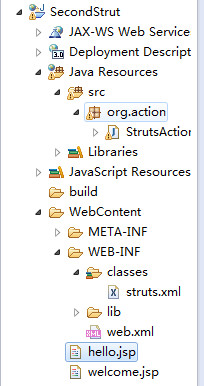打开http://struts.apache.org/网站,下载strut2
版本选择:
Full Distribution: Struts2完整版 建议下载该项(此版包括以下4项);
Example Applications: Struts2的示例应用,完整版已包括;
Essential Dependencies Only: Struts2的核心库,完整版已包括;
Docmentation: Struts2相关文档,包含Struts2的使用文档、参考手册和API文档等。完整版已包括;
Source:Struts2源代码,如需阅读Struts2源码,需要结合XWork源码点这里 获得。完整版已包括;
Full Distribution该目录结构下包括
apps:示例应用;
docs:相关文档,包括Struts 2的快速入门、Struts 2的文档、以及API文档等内容;
lib:核心类库,以及Struts 2 的第三方插件类库;
src:Struts 2框架的全部源代码。
提示 由于Struts 2必须需要依赖于是XWork,因此读者阅读Struts 2源代码时必须结合XWork的源码,而该src文件夹下并没有提供XWork的源代码。读者必须自行下载XWork源码,下载XWork源码请登录http://www.opensymphony.com/xwork/站点下载。
将lib文件夹下的struts2-core-2.1.6.jar、xwork-2.1.2.jar和ognl-2.6.11.jar等必需类库复制到Web应用的WEB-INF/lib路径下。当然,如果你的Web应用需要使用Struts 2的更多特性,则需要将更多的JAR文件复制到Web应用的WEB-INF/lib路径下。如果需要在DOS或者Shell窗口下手动编译Struts 2相关的程序,则还应该将struts2-core-2.1.6.jar和xwork-2.1.2.jar添加到系统的CLASSPATH环境变量里。(一般5个:
struts2-core-2.0.11.1.jar
xwork-2.0.4.jar
commons-logging-1.0.4.jar
freemarker-2.3.8.jar
ognl-2.6.11.jar)
提示 大部分时候,使用Struts 2的Web应用并不需要利用到Struts 2的全部特性,因此没有必要一次将该lib路径下JAR文件全部复制到Web应用的WEB-INF/lib路径下。
注意:我下的是strut2 2.3的版本,更上面的不同:
struts2.2.3最小jar包:
struts2-core-2.2.3.jar :Struts 2框架的核心类库
xwork-core-2.2.3.jar :XWork类库,Struts 2在其上构建
commons-fileupload-1.2.2.jar :文件上传组件,2.1.6版本后必须加入此文件
commons-io-2.0.1.jar
commons-lang-2.5.jar
commons-logging-1.1.1.jar :日志包,Struts 2框架使用这个日志包来支持Log4J和JDK 1.4+的日志记录。
freemarker-2.3.16.jar :Struts 2的UI标签的模板
javassist-3.11.0.GA.jar :唯一一个特殊的jar包,此包不在struts2的lib文件夹中。
ognl-3.0.1.jar :对象图导航语言(Object Graph Navigation Language),struts2框架通过其读写对象的属性
编辑Web应用的web.xml配置文件,配置Struts 2的核心Filter。下面是增加了Struts 2的核心Filter配置的web.xml配置文件的代码:
<?xml version="1.0" encoding="GBK"?> <!-- 配置Web应用配置文件的根元素,并指定配置文件的Schema信息 --> <web-app xmlns="http://java.sun.com/xml/ns/javaee" xmlns:xsi="http://www.w3.org/2001/XMLSchema-instance" xsi:schemaLocation="http://java.sun.com/xml/ns/javaee http://java.sun.com/xml/ns/javaee/web-app_2_5.xsd" version="2.5"> <!-- 定义Struts 2的核心控制器:FilterDispatcher --> <filter> <!-- 定义核心Filter的名字 --> <filter-name>struts2</filter-name> <!-- 定义核心Filter的实现类 --> <filter-class>org.apache.struts2.dispatcher.ng.filter.StrutsPrepareAndExecuteFilter </filter-class> </filter> <!-- FilterDispatcher用来初始化Struts 2并且处理所有的HTTP请求 --> <filter-mapping> <filter-name>struts2</filter-name> <url-pattern>/*</url-pattern> </filter-mapping> </web-app>
注意:
如果struts2版本是2.1及以前
web.xml配置过滤器的时候应该是这样:
<filter-class>org.apache.struts2.dispatcher.FilterDispatcher</filter-class>
如果struts2 版本是2.1以上,web.xml配置:
<filter-class>org.apache.struts2.dispatcher.ng.filter.StrutsPrepareAndExecuteFilter</filter-class>
错误分析
java.lang.NoClassDefFoundError: org/apache/commons/io/FileUtils
解决:缺少commons io包
java.lang.NoClassDefFoundError: org/apache/commons/lang/StringUtils
解决:缺少commons lang包
java.lang.ClassNotFoundException: javassist.ClassPool
解决:缺少javassist包
我用的是eclipse ee,apache版本是1.7,新建一个dynamic web project没有看到web.xml,为什么呢?是因为新建工程时最后一个选项会让你选择是否产生web.xml,勾选就可以了。参考;http://www.iteye.com/problems/62504
创建hello.jsp
<%@ page language="java" contentType="text/html; charset=utf-8" pageEncoding="utf-8"%> <!DOCTYPE html PUBLIC "-//W3C//DTD HTML 4.01 Transitional//EN" "http://www.w3.org/TR/html4/loose.dtd"> <html> <head> <meta http-equiv="Content-Type" content="text/html; charset=utf-8"> <title>strut2 应用</title> </head> <body> <form action="struts.action" method="post"> 请输入姓名:<input type="text" name="name" /><br/> <input type="submit" value="提交"> </form> </body> </html>
当点击提交按钮时,就会交给struts.actiion,strut2的filter拦截器就会起作用,将用户请求转发给相应的action类。
下面编写action类的实现。
理论上,Action可以不继承任何类或实现任何接口,以增强程序的可测试性,这也是和Struts1.X不同的地方。但是,继承自ActionSupport可以减少更多的编码工作。
在ActionSupport中,定义了方法execute(),当用户向该Action发送请求时,会自动调用。程
在src目录下的org.action包中:
package org.action; import java.util.Map; import com.opensymphony.xwork2.ActionContext; import com.opensymphony.xwork2.ActionSupport; public class StrutsAction extends ActionSupport { private String name; public String getName() { return this.name; } public void setName(String name) { this.name=name; } public String execute() throws Exception { if(!name.equals("HelloWorld")) { Map request=(Map)ActionContext.getContext().get("request"); request.put("name", getName()); return "success"; } else { return "error"; } } }
配置struts.xml
struts.xml文件应该在哪里,放在WEB-INF/classes路径下,也就是web应用程序类路径。WEB应用程序的类路径是指WEB-INF/classes目录,在Eclipse中,创建在src目录下的文件最终发布后会自动复制到WEB-INF/classes目录下。也就是说放在src目录也没用问题(经过测试,确实如此.
struts.xml:
<?xml version="1.0" encoding="UTF-8" ?> <!DOCTYPE struts PUBLIC "-//Apache Software Foundation//DTD Struts Configuration 2.0//EN" "http://struts.apache.org/dtds/struts-2.0.dtd"> <struts> <package name="default" extends="struts-default"> <action name="struts" class="org.action.StrutsAction"> <result name="success">/welcome.jsp</result> <result name="error">/hello.jsp</result> </action> </package> </struts>
strut.xml可以中涉及到很多标签,以下是简单的解释:
|
标签名称 |
说明 |
|
include |
包含其他xml文件,在示例中,这意味着struts.xml可以访问定义在struts-default.xml文件中的组件。 该元素可以使得Struts2定义多个配置文件,“分而治之”。 要注意的是,任何一个struts2配置文件都应该和struts.xml有相同的格式,包括doctype,并且可以放在类路径下的任何地方。 |
|
package |
为Action或截拦器分组。 name:名称,必填项,名称自定义,没特别要求。方便别的package引用。 extends:package能继承其他的package,即通过该属性实现,值为另一个package的name。 在示例中,extends =”struts-default”是从struts-default.xml中继承的。 |
|
action |
定义Action,name属性为访问时用到的名称,class属性是Action的类名。 |
|
result |
根据Action的返回值定义页面导航。 Action的预定义的返回值有: String SUCCESS = "success"; String NONE = "none"; String ERROR = "error"; String INPUT = "input"; String LOGIN = "login"; 比如,当Action返回SUCCESS时希望转到ok.jsp页面,则可以这样写: <result name=”success”>/ok.jsp</result> 其中,name的缺省为success。
|
welcome.jsp:
<%@ page language="java" contentType="text/html; charset=utf-8" pageEncoding="utf-8"%> <%@ taglib uri="/struts-tags" prefix="s" %> <!DOCTYPE html PUBLIC "-//W3C//DTD HTML 4.01 Transitional//EN" "http://www.w3.org/TR/html4/loose.dtd"> <html> <head> <meta http-equiv="Content-Type" content="text/html; charset=ISO-8859-1"> <title>Insert title here</title> </head> <body> hello<s:property value="#request.name"/> </body> </html>
项目的文件组织结构如下:

参考了:
http://my.oschina.net/tomzhao/blog/23782
http://www.blogjava.net/lzhidj/archive/2008/07/08/213445.html